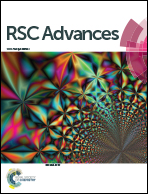Microwave-assisted hydrothermal synthesis and spectroscopic characteristics of a Lu4Hf3O12:Pr scintillator†
Abstract
Exclusively high density of Lu4Hf3O12 makes it an attractive host for scintillator materials. This paper presents the versatility of microwave-assisted hydrothermal technology (MAH) to fabricate nanocrystalline Lu4Hf3O12:Pr luminescent powder. It is shown that by varying the parameters of the fabrication procedure, changing the composition of the liquid medium and/or using polyethylene glycol, PEG 2000, as a surfactant, the morphology of the powders could be modified. In the presence of PEG, obtaining non-agglomerated particles ∼5 nm in diameter was possible. Sintered ceramics at 1700 °C were fabricated using various powders. Photoluminescence and X-ray excited emission spectra showed the Pr3+ emission resulting from 4f → 4f transitions. At room temperature the 3P0 and 1D2 levels contributed roughly equally to the total emission in both the powders and sintered ceramics. The former produced luminescence with a decay time of ∼15 μs while the latter was an order of magnitude slower. At 10 K the emission resulted almost exclusively from the 3P0 level. In addition, a broad-band blue luminescence was observed at low temperatures. Room temperature radioluminescence (RL) was found to be rather inefficient in both the powders and ceramics.


 Please wait while we load your content...
Please wait while we load your content...